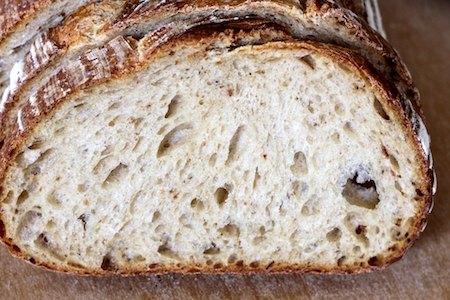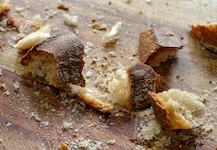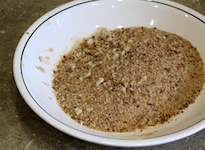
Using old bread to make new bread is certainly nothing new. The practice of adding an “old bread soaker” to dough has been used in Europe, especially Germany, for hundreds of years. In Bread: A Baker’s Book of Techniques and Recipes, Jeffrey Hamelman writes, “The practice of soaking old bread and then adding it into a new batch not only makes economic sense, it also gives a rich depth of flavor to the new breads. Far from being expended, the old bread contains much that is still fermentable…”
This sourdough bread uses old bread in a slightly different way. Instead of soaking it, I wanted to find out what would happen if I turned some week-old Norwich Sourdough (crust and all) into fine bread crumbs and simply let the crumbs stand in for a portion of the flour in a new batch of dough.
I have to say I’m pretty pleased with the result. Not only is the flavor rich and toasty, and the crumb pleasantly speckled with brown flecks, but this must be one of the longest shelf-lives I’ve ever seen with any of my loaves. I’ve gone through about 2/3 of a one-kilogram loaf in a week, and I am still able to cut, chew, and enjoy it.

The recipe is essentially Norwich Sourdough with the rye flour (about 10% of the total flour in the dough) replaced with bread crumbs. I also cut back on the salt a bit to account for the fact that some salt was already in the crumbs. I kept the hydration the same, and I think that was about right.
To make the bread crumbs, I cut approximately one-inch pieces of the old bread and ground them in a food processor until they were mostly quite fine but still had a bit of texture.


Bread Crumb Sourdough
Yield: 2 kg (4 small or 2 large loaves)
Time:
- Mix/autolyse: 35 minutes
- First fermentation: 3 hours, with folds at 1 hour and 2 hours
- Divide, bench rest, and shape: 20 minutes
- Proof: 2.5 – 3 hours
- Bake: 40 minutes
Ingredients:
- 920 g flour
- 120 g Norwich Sourdough bread crumbs
- 600 g water
- 20 g (3-1/3 t.) salt
- 360 g mature 100%-hydration sourdough starter
Method:
- In the bowl of a stand mixer, mix the flour, bread crumbs, water, and starter on low speed until just combined, about one minute.
- Cover and let the dough rest (autolyse) for 30 minutes.
- Add the salt and continue mixing on low or medium speed until the dough reaches a medium level of gluten development. This should only take about 3 or 4 minutes, maybe less.
- Transfer the dough to an oiled container and ferment at room temperature for 3 hours, with folds at one and two hours.
- Turn the dough out onto a lightly floured counter. Divide it into 500 g – 1000 g pieces and preshape them into light balls.
- Sprinkle the balls lightly with flour, cover loosely with plastic, and let rest for 15 minutes.
- Shape into batards or boules and place seam-side-up in a floured couche or baskets.
- Cover and proof at room temperature for 2.5 – 3 hours, or until the indentation left by a fingerprint springs back very slowly.
- Meanwhile, preheat the oven, with baking stone, to 475F. You will also need steam during the initial phase of baking, so prepare for this now.
- Turn the proofed loaves onto a semolina-sprinkled peel or parchment and slash them as you like.
- Once the loaves are in the oven, turn the heat down to 450F. For 500-gram loaves, bake for 5 minutes with steam, and another 25 minutes without steam. Then turn off the oven and leave the loaves in for 10 minutes longer, with the door ajar, to help them dry. Larger loaves will need to be baked longer.
- Cool on a wire rack.
Great idea Susan and a very beautiful loaf. I like the idea that the loaf may last longer without getting stale as quickly.
What a splendid loaf!
Cheers,
Rosa
I really like that idea! Appeals to a spot of thriftiness in me I suppose. It also reminds me of one of the first more complicated recipes I tried long time ago and the recipe made me wonder if I really had to use breadcrumbs in the dough. (thinking I didn’t understand it right).
Lovely loaf and beautiful crust!
Great idea and a beautiful loaf and crumb.
Superb looking bread. I feel compelled to bake it this minute – such is the power of Wild Yeast over me. Thank you!
Somewhat off-topic, I’m wondering if you notice distinct differences between sourdoughs from different parts of the U.S.?
This is interesting Susan, I might try it ! Thank you.
Lovely bread, as always, Susan.
On a similar theme my bread last week was made with leftover porridge made with BRM steel cut oats (and toasted hazelnuts). The crumb was really moist and I am still eating it untoasted almost a week later.
Did you toast the breadcrumbs? I think that would add another layer of flavor.
While I typically enjoy longer shelf life from sourdough breads did you find that the addition of the breadcrumbs extended it even more?
allan
Great loaf! I am just reading JH’s black pumpernickel recipe and it needs old bread too. Do you figure I could just use country bread for the old bread? I don’t have any old rye.
I guess I’d never thought about using old bread to make new but it does make sense. Beautiful looking loaf!
Brock, I have only baked bread here in northern California, with sourdough raised here, and the question of whether sourdough starters can claim “terroir” is debatable. I don’t think it’s true that “San Francisco Sourdough” can only be made here. http://www.wildyeastblog.com/2008/04/22/sourdough-stories-myth/
What has been your experience?
Allan, I didn’t toast the crumbs this time but that’s a great idea. It does seem to me that this loaf has lasted even longer than what I usually get with sourdough, but I hesitate to draw a general conclusion with an N of one.
Thanks to all for your nice comments!
It certainly takes passion and skill to bake such beautiful loaves. You have much to be proud of. I used to bake a lot of bread. When I lived in San Diego my next door neighbors were Jewish and I’d take a braided Challah I made myself over to them on Friday afternoon in time for their Friday Sabbath dinner. I used to make a loaf for me, too. Even though I’m not Jewish I love the eggy, butter taste. Almost like the French brioche.
So many food traditions move from one region to another. Mass migrations of people that took place centuries ago caused people to leave their homes with a small satchel of food and a few recipes. Bread is one of those items you’ll find around the globe. From Parker House rolls to Baguettes to Chinese Steamed buns.
a loaf that could last a week? sounds interesting. in times of crisis all we need is a little creativity in food. and spoilage won’t take place. i love your idea of using left over loaves to a new recipe.
I, too, have used the old bread soaker and the results were fabulous. I’m not sure why, but it makes a great bread. And your loaves are beautiful!
Oh, I would love to be in my own home to try this recipe, as Norwich sourdough is (used to be) my default bread for weekend baking
it will have to wait, but I’m definitely saving this
Beautiful loaf, Susan….
Stunning loaf, Susan. I’m going to have to get my starter going.
What a lovely looking loaf. I think I will be coming back to this one…
It’s a good thing that loaf isn’t within reaching distance from me because I’d probably eat the whole thing. It looks perfect! Great slash marks – I can never get mine to look so good
🙂
ButterYum
It looks tasty and crisp, this is very mouth-watering=)
It’s got to be wonderful; it contains the infamous Norwich recipe!
I’ve got to try this. The hard part will be ‘saving’ some bread as ‘leftovers’ in order to do it!
Gorgeous loaf Susan and a great way to ‘recycle’ bread in a new loaf. The toasting of the crumbs sounds nice, too.
I bake my bread crumb sourdough rounds in cast iron dutch ovens. I preheat @450, then reduce to 375 and bake 25mn covered, 20 uncovered. I really like the sour taste of the loaves. I refridgerate the dough overnight and then shape and proof the next day. The problem is my bottom crust has always been too tough and chewy. Do you know how I can fix this?
I never heard of this method…makes perfect sense.
I’m loving your site! My two little munchkins just took steak knives to my cooling sourdough loaves, it’s no longer usuable so this recipe will save some bread for me. Still questioning my fitness as a mother though:)
This is really nice to know about bread crumb.
I have always beaten myself up when I’ve let good bread go stale!
In South Africa they make a delicious Pap Tert (Afrikaans)- a tart made from cooked, soft maize meal porridge & cooked savoury ingredients- onions, mushrooms,bacon tomatoes layered in a dish, cheese sprinkled on top & baked @170c for +|- 1 hr.
I have thought to do something similar with half a small stale rye loaf, mixed with oats. Standing in front of the dish, I had a sinking feeling “this won’t work! It’ll be as heavy as lead!”
I haven’t mixed anything yet except the water-soaked rye & the oats.
I’m going to throw a cloth over it till tomorrow morning.
Can anyone help me?
Thanks for a fabulous site!
Wendy